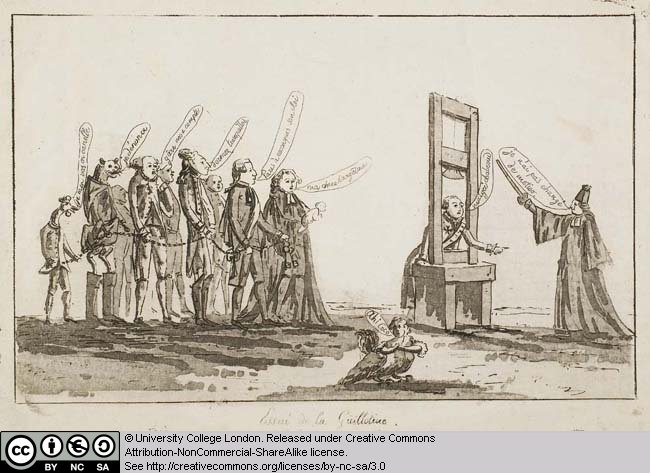11 Trying Out the Guillotine

Anon
Essai de la Guillotine
(Trying out the Guillotine) , c. 1793
Etching and aquatint
Publisher unrecorded
This is a highly enigmatic print whose meaning has become
obscured over time, although we can assume that it would have been obvious to
its originally intended audience. It is probable, for example, that members of
the crowd (cockerel and puss-in-boots excepted) were caricatures of well-known
personages yet today their identities remain ambiguous. The only exceptions
might be Louis XVI with his head beneath the guillotine and the fourth and
fifth figures from the left who, on the basis of their physiognomy we might
guess are caricatures of Lafayette
and Bailly,
(once commander of the National Guard and Mayor of Paris, respectively). Their
speech-bubbles do not help clarify their identity, nor do they explain the
nature of the scene depicted, in part as a result of their deployment of slang
and ambiguous references. The dialogue between the figure of Louis XVI and a lawyer
(recognisable from his dress and baton) is particularly puzzling: the lawyer
states to the king: ‘I have not changed my profession’, to which Louis replies
simply, ‘despite Chabroud?’ This is surely a reference to Jean-Baptiste-Charles
Chabroud, one time president of the National Assembly and advocate of legal
reforms who sought to limit the powers of the king through the nomination of
judges. Yet the exact meaning of their exchange remains unknown.
The print’s joke would seem to be at the expense of the
crowd of men who watch the king go to his death whilst making callous remarks.
One of them (
Licensed under the Creative Commons Attribution Non-commercial Share Alike 3.0 License
This resource has been released as an open educational resource (OER) on a Creative Commons 'Attribution Non-commercial Share Alike' license. This means that once downloaded, content can be modified and improved to complement a particular course. This requires, however, that improvements are recycled back into the OER community. All content present at the time of download must be accordingly credited and, in turn, novel content must be appropriately licensed.